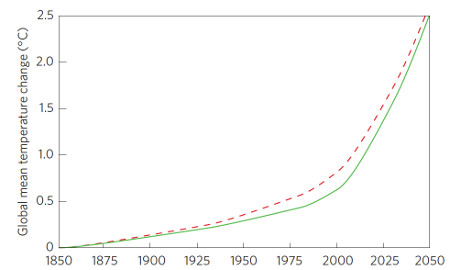
We hear a lot of talk these days about climate sensitivity. It is often considered the most important measure for predicting how much the Earth's temperature will increase as we emit heat-trapping gases like carbon dioxide.
But, the term sensitivity has to be used carefully because it can mean different things in different contexts. For instance, there is a long-term (equilibrium) sensitivity to doubling carbon dioxide which refers to the ultimate temperature reached by the planet if we were to double carbon dioxide. There are also shorter term (transient) sensitivities which relate to temperature changes as heat trapping gases increase at some specified rate.
Values for climate sensitivity in general can be obtained many ways. My favorite way is by looking at deep history. If we can measure how sensitive the climate was in the past, perhaps we can infer its sensitivity now. A second way is through the use of modern temperature records and recent greenhouse gas levels. A third way is through the use of climate models (computer programs that replicate the Earth climate system). Regardless of the method used, there is general agreement that if we were to double carbon dioxide, the Earth's surface temperature would eventually increase by 1.5–4.5°C (2.7–8.1°F). Obviously, if the Earth sensitivity is at the upper end of the range, we are in trouble.
Recently, there have been some studies which suggest that maybe the climate sensitivity is at the lower end of this range. Most of these studies have only used the second method to calculate sensitivity, a fact that will soon become important. In addition to real science studies, there have been policy organizations that have promoted these low-sensitivity results. But my question is, what does the science say? Fortunately, a paper just published in Nature Climate Change provides some guidance on this question. The study was completed by Dr. Drew Shindell from NASA, and what he found was exciting. It turns out, not all Watts are equal. Energy changes to the Earth system from changes of sun-reflecting particulates or from ozone have a different impact than energy changes from carbon dioxide.
The Earth has a greater sensitivity to particulates and ozone than to carbon. The reason for this seemingly strange behavior is that aerosols are largely located near industrialized areas in the Northern Hemisphere. This hemisphere also happens to contain much more land area than the south – and land regions are more sensitive to changes in energy, at least in the near term. In short, particulates and ozone impact more sensitive parts of the planet. Carbon dioxide, on the other hand, spreads out uniformly across the globe – it doesn't accumulate in one hemisphere or another.
However, let's not get too excited about particulates saving us from global warming. Dr. Shindell also showed that while in the short run, the cooling effect from particulates matters a lot, in the long run, it doesn't make much of a difference. The impact can be seen in this figure which shows the prior expectations of the climate (dashed line) alongside the revised prediction (solid). By 2050, there really is little difference.

Temperature responses for uniform heating (dashed) and new non-uniform heating (solid).
What does this have to do with climate sensitivity?
Posted by John Abraham on Tuesday, 11 March, 2014
 |
The Skeptical Science website by Skeptical Science is licensed under a Creative Commons Attribution 3.0 Unported License. |